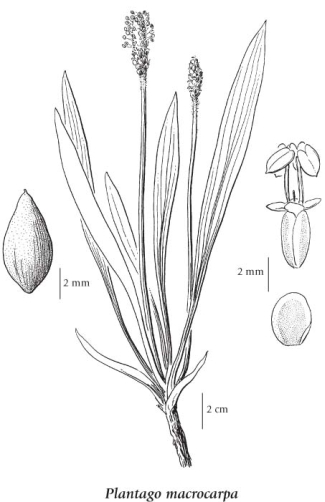Plantago macrocarpa Cham. & Schltdl.
Alaska plantain (seashore plantain)
Plantaginaceae (Mare's-tail family)
Introduction to Vascular Plants
Alaska plantain (seashore plantain)
Plantaginaceae (Mare's-tail family)
Introduction to Vascular Plants
Species Information
General:
Perennial herb from a stout taproot; stems erect, numerous, simple, hollow, smooth or sometimes hairy above when young, 25-45 (60) cm tall.
Leaves:
Basal leaves lanceolate to oblanceolate, smooth, several-veined, 10-45 cm long, 1-3.5 cm wide, narrowed at the base to the distinct stalks, entire; stem leaves lacking.
Flowers:
Inflorescence of short, dense, bracteate spikes, the spikes short at first then elongate, 5-15 cm long; corollas greenish to brownish, 4-lobed, the lobes 1.5-2 mm long, spreading; bracts shorter than the flowers; stamens conspicuous.
Fruits:
Capsules, egg-shaped, 5-7 mm long; seeds 1-2, black, slightly concave, roughened.
Illustration

If more than one illustration is available for a species (e.g., separate illustrations were provided for two subspecies) then links to the separate images will be provided below. Note that individual subspecies or varietal illustrations are not always available.
Illustration Source: The Illustrated Flora of British Columbia
Ecology
Ecological Framework for Plantago macrocarpa
The table below shows the species-specific information calculated from
original data (BEC database) provided by the BC Ministry of Forests and Range.
(Updated August, 2013)
The table below shows the species-specific information calculated from
original data (BEC database) provided by the BC Ministry of Forests and Range.
(Updated August, 2013)
| Site Information |
Value / Class |
||
|
Avg |
Min |
Max |
|
| Elevation
(metres) |
33 | 0 | 535 |
| Slope
Gradient (%) |
5 | 0 | 120 |
|
Aspect (degrees) |
319 | 8 | 275 |
| Soil
Moisture Regime (SMR) [0 - very xeric; 4 - mesic; 8 - hydric] |
5 | 2 | 7 |
| Modal
Nutrient Regime
Class |
D | ||
| #
of field plots species was recorded in: |
39 | ||
| Modal
BEC Zone Class |
CWH | ||
|
All BEC Zones (# of stations/zone) species was recorded in |
CWH(38), ICH(1) | ||
|
Source:
Klinkenberg 2013
|
|||
Habitat and Range
Moist to wet meadows, beaches, upper tidal marshes, shorelines and bogs in the lowland zone; infrequent along the coast in BC; amphiberingian, N to S AK and S to OR, E Asia.Status Information
Taxonomic Notes
"The family Plantaginaceae includes three genera and an estimated 250-275 species from diverse habitats throughout the world (Pilger 1937). In Canada, the family is represented by two genera containing seven introduced species and ten native species"(Bassett 1973).
References Bassett, I. John. 1973. The Plantains of Canada. Monograph No. 7. Canada Department of Agriculture. |